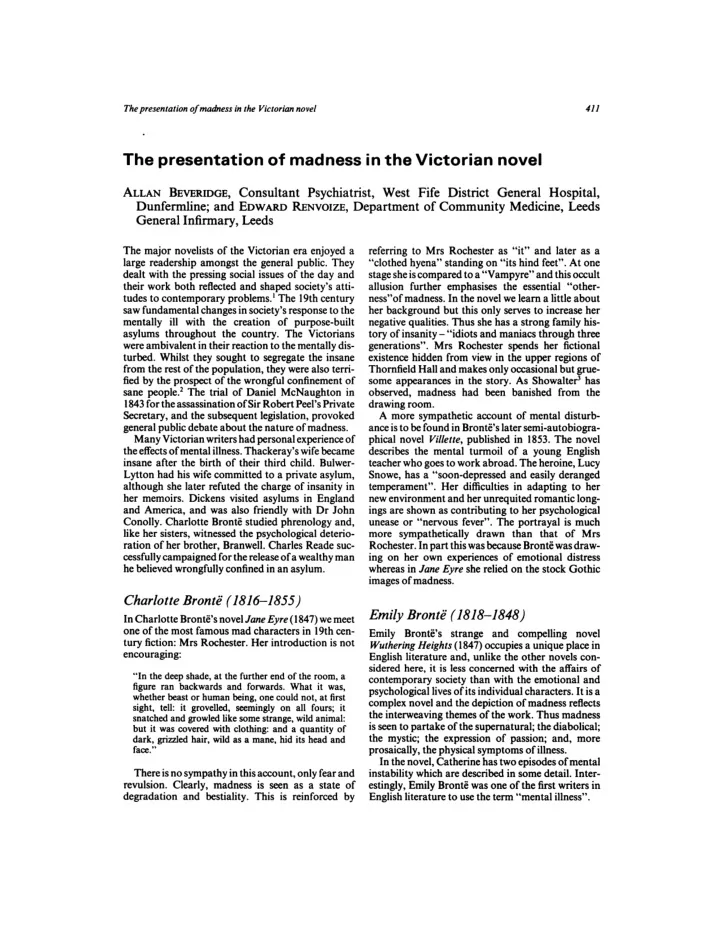

Thepresentation of madness in the Victoriannovel 411 The presentation of madness in the Victorian novel ALLAN BEVERIDGE, Consultant Psychiatrist, West Fife District General Hospital, Dunfermline; and EDWARD RENVOIZE, Department of Community Medicine, Leeds General Infirmary, Leeds referring to Mrs Rochester as "it" and later as a The major novelists of the Victorian era enjoyed a "clothed hyena" standing on "its hind feet". At one large readership amongst the general public. They stage she iscompared to a "Vampyre" and this occult dealt with the pressing social issues of the day and their work both reflected and shaped society's atti allusion further emphasises the essential "other- ness"of madness. In the novel we learn a little about tudes to contemporary problems.1 The 19th century saw fundamental changes in society's response to the her background but this only serves to increase her mentally ill with the creation of purpose-built negative qualities. Thus she has a strong family his tory of insanity - "idiots and maniacs through three asylums throughout the country. The Victorians generations". Mrs Rochester spends her fictional were ambivalent in their reaction to the mentally dis turbed. Whilst they sought to segregate the insane existence hidden from view in the upper regions of from the rest of the population, they were also terri Thornfield Hall and makes only occasional but grue some appearances in the story. As Showalter3 has fied by the prospect of the wrongful confinement of sane people.2 The trial of Daniel McNaughton in observed, madness had been banished from the 1843for the assassination of Sir Robert Peel's Private drawing room. Secretary, and the subsequent legislation, provoked A more sympathetic account of mental disturb ance is to be found in Bronte's later semi-autobiogra general public debate about the nature of madness. Many Victorian writers had personal experience of phical novel Villette, published in 1853. The novel the effects of mental illness. Thackeray's wife became describes the mental turmoil of a young English insane after the birth of their third child. Bulwer- teacher who goes to work abroad. The heroine, Lucy Snowe, has a "soon-depressed and easily deranged Lytton had his wife committed to a private asylum, temperament". Her difficulties in adapting to her although she later refuted the charge of insanity in her memoirs. Dickens visited asylums in England new environment and her unrequited romantic long and America, and was also friendly with Dr John ings are shown as contributing to her psychological unease or "nervous fever". The portrayal is much Conolly. Charlotte Bronte studied phrenology and, like her sisters, witnessed the psychological deterio more sympathetically drawn than that of Mrs ration of her brother, Branwell. Charles Reade suc Rochester. In part this was because Bronte was draw cessfully campaigned for the release of a wealthy man ing on her own experiences of emotional distress he believed wrongfully confined in an asylum. whereas in Jane Eyre she relied on the stock Gothic images of madness. Charlotte Bronte (1816-1855) Emily Bronte (1818-1848) In Charlotte Bronte's novel Jane Eyre (1847)we meet Emily Bronte's strange and compelling novel one of the most famous mad characters in 19th cen tury fiction: Mrs Rochester. Her introduction is not Wuthering Heights (1847)occupies a unique place in encouraging: English literature and, unlike the other novels con sidered here, it is less concerned with the affairs of "In the deep shade, at the further end of the room, a contemporary society than with the emotional and figure ran backwards and forwards. What it was, psychological lives of its individual characters. It is a whether beast or human being, one could not, at first complex novel and the depiction of madness reflects sight, tell: it grovelled, seemingly on all fours; it the interweaving themes of the work. Thus madness snatched and growled like some strange, wild animal: is seen to partake of the supernatural; the diabolical; but it was covered with clothing: and a quantity of the mystic; the expression of passion; and, more dark, grizzled hair, wild as a mane, hid its head and face." prosaically, the physical symptoms of illness. In the novel, Catherine has two episodes of mental There is no sympathy in this account, only fear and instability which are described in some detail. Inter revulsion. Clearly, madness is seen as a state of estingly, Emily Bronte was one of the first writers in English literature to use the term "mental illness". degradation and bestiality. This is reinforced by
Recommend
More recommend